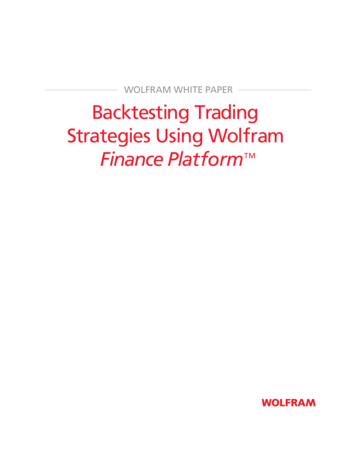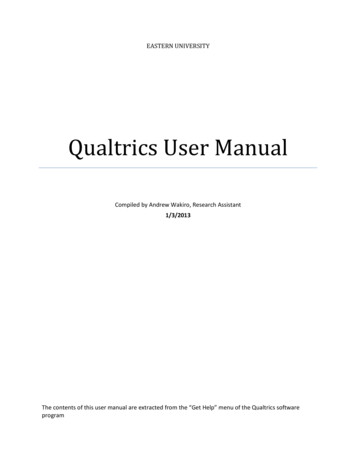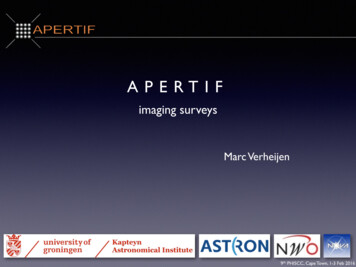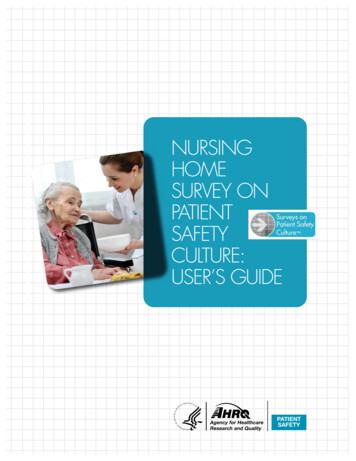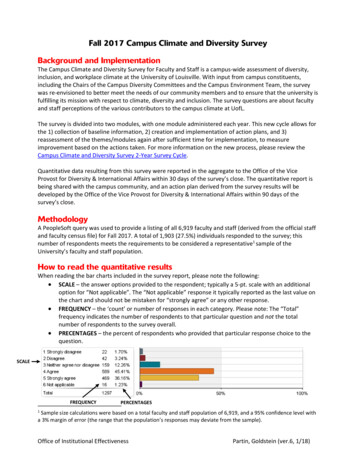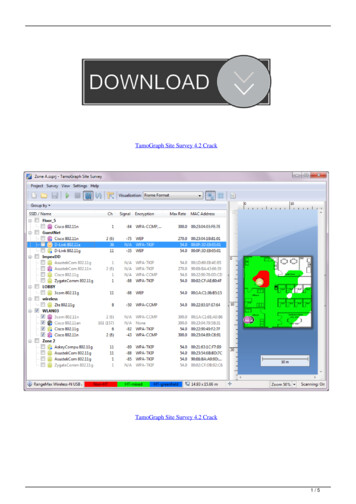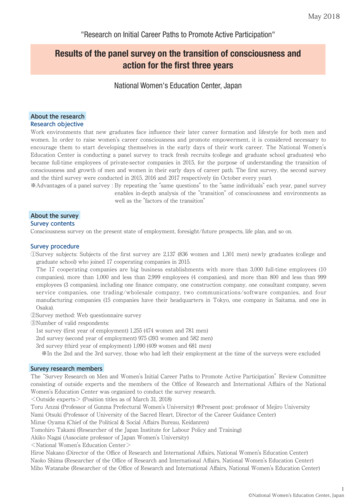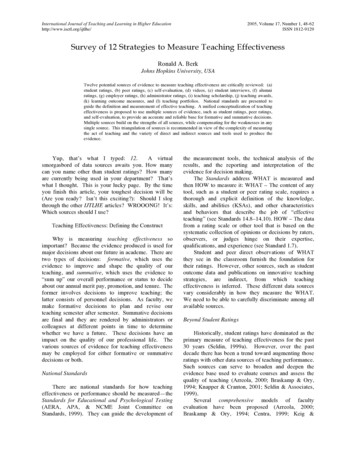
Transcription
International Journal of Teaching and Learning in Higher Educationhttp://www.isetl.org/ijtlhe/2005, Volume 17, Number 1, 48-62ISSN 1812-9129Survey of 12 Strategies to Measure Teaching EffectivenessRonald A. BerkJohns Hopkins University, USATwelve potential sources of evidence to measure teaching effectiveness are critically reviewed: (a)student ratings, (b) peer ratings, (c) self-evaluation, (d) videos, (e) student interviews, (f) alumniratings, (g) employer ratings, (h) administrator ratings, (i) teaching scholarship, (j) teaching awards,(k) learning outcome measures, and (l) teaching portfolios. National standards are presented toguide the definition and measurement of effective teaching. A unified conceptualization of teachingeffectiveness is proposed to use multiple sources of evidence, such as student ratings, peer ratings,and self-evaluation, to provide an accurate and reliable base for formative and summative decisions.Multiple sources build on the strengths of all sources, while compensating for the weaknesses in anysingle source. This triangulation of sources is recommended in view of the complexity of measuringthe act of teaching and the variety of direct and indirect sources and tools used to produce theevidence.Yup, that’s what I typed: 12.A virtualsmorgasbord of data sources awaits you. How manycan you name other than student ratings? How manyare currently being used in your department? That’swhat I thought. This is your lucky page. By the timeyou finish this article, your toughest decision will be(Are you ready? Isn’t this exciting?): Should I slogthrough the other IJTLHE articles? WROOONG! It’s:Which sources should I use?Teaching Effectiveness: Defining the ConstructWhy is measuring teaching effectiveness soimportant? Because the evidence produced is used formajor decisions about our future in academe. There aretwo types of decisions: formative, which uses theevidence to improve and shape the quality of ourteaching, and summative, which uses the evidence to“sum up” our overall performance or status to decideabout our annual merit pay, promotion, and tenure. Theformer involves decisions to improve teaching; thelatter consists of personnel decisions. As faculty, wemake formative decisions to plan and revise ourteaching semester after semester. Summative decisionsare final and they are rendered by administrators orcolleagues at different points in time to determinewhether we have a future. These decisions have animpact on the quality of our professional life. Thevarious sources of evidence for teaching effectivenessmay be employed for either formative or summativedecisions or both.National StandardsThere are national standards for how teachingeffectiveness or performance should be measured—theStandards for Educational and Psychological Testing(AERA, APA, & NCME Joint Committee onStandards, 1999). They can guide the development ofthe measurement tools, the technical analysis of theresults, and the reporting and interpretation of theevidence for decision making.The Standards address WHAT is measured andthen HOW to measure it: WHAT – The content of anytool, such as a student or peer rating scale, requires athorough and explicit definition of the knowledge,skills, and abilities (KSAs), and other characteristicsand behaviors that describe the job of “effectiveteaching” (see Standards 14.8–14.10). HOW – The datafrom a rating scale or other tool that is based on thesystematic collection of opinions or decisions by raters,observers, or judges hinge on their expertise,qualifications, and experience (see Standard 1.7).Student and peer direct observations of WHATthey see in the classroom furnish the foundation fortheir ratings. However, other sources, such as studentoutcome data and publications on innovative teachingstrategies, are indirect, from which teachingeffectiveness is inferred. These different data sourcesvary considerably in how they measure the WHAT.We need to be able to carefully discriminate among allavailable sources.Beyond Student RatingsHistorically, student ratings have dominated as theprimary measure of teaching effectiveness for the past30 years (Seldin, 1999a). However, over the pastdecade there has been a trend toward augmenting thoseratings with other data sources of teaching performance.Such sources can serve to broaden and deepen theevidence base used to evaluate courses and assess thequality of teaching (Arreola, 2000; Braskamp & Ory,1994; Knapper & Cranton, 2001; Seldin & Associates,1999).Several comprehensive models of facultyevaluation have been proposed (Arreola, 2000;Braskamp & Ory, 1994; Centra, 1999; Keig &
BerkStrategies to Measure Teaching EffectivenessWaggoner, 1994; Romberg, 1985; Soderberg, 1986).They include multiple sources of evidence with greaterweight attached to student and peer input and trators, and others. All of these models are usedto arrive at formative and summative decisions.A Unified ConceptualizationI propose a unified conceptualization of teachingeffectiveness, whereby evidence is collected from avariety of sources to define the construct and to makedecisions about its attainment. Much has been writtenabout the merits and shortcomings of the varioussources of evidence currently being employed. Eachsource can supply unique information, but also isfallible, usually in a way different from the othersources. For example, the unreliability or biases of peerratings are not the same as those of student ratings;student ratings have other weaknesses. By drawing onthree or more different sources of evidence, thestrengths of each source can compensate forweaknesses of the other sources, thereby converging ona decision about teaching effectiveness that is moreaccurate than one based on any single source (Appling,Naumann, & Berk, 2001). This notion of triangulationis derived from a compensatory model of decisionmaking. Given the complexity of measuring the act ofteaching, it is reasonable to expect that multiple sourcescan provide a more accurate, reliable, andcomprehensive picture of teaching effectiveness thanjust one source. However, the decision maker shouldintegrate the information from only those sources forwhich validity evidence is available (see Standard14.13).According to Scriven (1991), evaluation is “theprocess, whose duty is the systematic and objectivedetermination of merit, worth, or value. Without such aprocess, there is no way to distinguish the worthwhilefrom the worthless.” (p. 4) This process involves twodimensions: (a) gathering data and (b) using that datafor judgment and decision making with respect toagreed-upon standards. Measurement tools are neededto collect that data, such as tests, scales, andquestionnaires. The criteria for teaching effectivenessare embedded in the content of these measures. Themost common measures used for collecting the data forfaculty evaluation are rating scales.12 Sources of EvidenceThere are 12 potential sources of evidence ofteaching effectiveness: (a) student ratings, (b) peerratings, (c) self-evaluation, (d) videos, (e) studentinterviews, (f) alumni ratings, (g) employer ratings, (h)administrator ratings, (i) teaching scholarship, (j)teaching awards, (k) learning outcome measures, and (l)teaching portfolio. An outline of these sources isshown in Table 1 along with several salientcharacteristics: type of measure needed to gather theevidence, the person(s) responsible for providing theevidence (students, peers, instructor, or administrator),the person or committee who uses the evidence, and thedecision(s) typically rendered based on that data (F formative/ S summative/ P program). The purposeof this article is to critically examine the value of these12 sources reported in the literature on facultyevaluation and to deduce a “bottom line”recommendation for each source based on the currentstate of research and practice.Student RatingsThe mere mention of faculty evaluation to manycollege professors conjures up mental images of the“shower scene” from Psycho. They’re thinking: “Whynot just whack me now, rather than wait to see thosestudent ratings again.” Student ratings have becomesynonymous with faculty evaluation in the UnitedStates (Seldin, 1999a).TABLE 1Salient Characteristics of 12 Sources of Evidence of Teaching EffectivenessSource of EvidenceType of Measure(s) Who Provides EvidenceWho Uses EvidenceStudent RatingsRating ScalePeer RatingsRating ScaleSelf-EvaluationRating ScaleVideosRating ScaleStudent InterviewsQuestionnairesAlumni RatingsRating ScaleEmployer RatingsRating ScaleAdministrator RatingsRating ScaleTeaching ScholarshipJudgmental ReviewTeaching AwardsJudgmental ReviewLearning OutcomesTests, Projects, SimulationsTeaching PortfolioMost of the above1F formative, S summative, P StudentsGraduatesGraduates’ ntsInstructors, Students, dministratorsAdministratorsAdministratorsFaculty Committees/AdministratorsInstructors/Curriculum CommitteesPromotions CommitteesType of Decision1F/S/PF/SF/SF/SF/SF/S/PPSSSF/PS
BerkIt is the most influential measure of performanceused in promotion and tenure decisions at institutionsthat emphasize teaching effectiveness (Emery, Kramer,& Tian, 2003). Recent estimates indicate 88% of allliberal arts colleges use student ratings for summativedecisions (Seldin, 1999a).A survey of 40,000department chairs (US Department of Education, 1991)indicated that 97% used “student evaluations” to assessteaching performance.This popularity not withstanding, there have alsobeen signs of faculty hostility and cynicism towardstudent ratings (Franklin & Theall, 1989; Nasser &Fresko, 2002; Schmelkin-Pedhazur, Spencer, &Gellman, 1997).Faculty have lodged numerouscomplaints about student ratings and their uses. Theveracity of these complaints was scrutinized byBraskamp and Ory (1994) and Aleamoni (1999) basedon accumulated research evidence. Both reviews foundbarely a smidgen of research to substantiate any of thecommon allegations by faculty. Aleamoni’s analysisproduced a list of 15 “myths” about student ratings.However, there are still dissenters who point toindividual studies to support their objections, despitethe corpus of evidence to the contrary. At present, alarge percentage of faculty in all disciplines exhibitmoderately positive attitudes toward the validity ofstudent ratings and their usefulness for improvinginstruction; however, there’s no consensus (Nasser &Fresko, 2002).There is more research on student ratings than anyother topic in higher education (Theall & Franklin,1990). More than 2000 articles have been cited overthe past 60 years (Cashin, 1999; McKeachie & Kaplan,1996). Although there is still a wide range of opinionson their value, McKeachie (1997) noted that “studentratings are the single most valid source of data onteaching effectiveness” (p. 1219). In fact, there is littleevidence of the validity of any other sources of data(Marsh & Roche, 1997). There seems to be agreementamong the experts on faculty evaluation that studentratings provides an excellent source of evidence forboth formative and summative decisions, with thequalification that other sources also be used for thelatter (Arreola, 2000; Braskamp & Ory, 1994; Cashin,1989, 1990; Centra, 1999; Seldin, 1999a). [DigressionAlert: If you’re itching to be provoked, there are severalreferences on the student ratings debate that may inciteyou to riot (see Aleamoni, 1999; Cashin, 1999;d’Apollonia & Abrami, 1997; Eiszler, 2002; Emery etal., 2003; Greenwald, 1997; Greenwald & Gilmore,1997; Greimel-Fuhrmann & Geyer, 2003; Havelka,Neal, & Beasley, 2003; Lewis, 2001; Millea & Grimes,2002; Read, Rama, & Raghunandan, 2001; Shevlin,Banyard, Davies, & Griffiths, 2000; Sojka, Gupta, &Deeter-Schmelz, 2002; Sproule, 2002; Theall, Abrami,& Mets, 2001; Trinkaus, 2002; Wachtel, 1998).Strategies to Measure Teaching Effectiveness50However, before you grab your riot gear, you mightwant to consider 11 other sources of evidence. End ofDigression].BOTTOM LINE: Student ratings is a necessary sourceof evidence of teaching effectiveness for both formativeand summative decisions, but not a sufficient source forthe latter. Considering all of the polemics over itsvalue, it is still an essential component of any facultyevaluation system.Peer RatingsIn the early 1990s, Boyer (1990) and Rice (1991)redefined scholarship to include teaching. After all, itis the means by which discovered, integrated, andapplied knowledge is transmitted to the next generationof scholars. Teaching is a scholarly activity. In orderto prepare and teach a course, faculty must complete thefollowing: Conduct a comprehensive up-to-date review ofthe literature. Develop content outlines. Prepare a syllabus. Choose the most appropriate print andnonprint resources. Write and/or select handouts. Integrate instructional technology (IT) support(e.g., audiovisuals, Web site). Design learning activities. Construct and grade evaluation measures.Webb and McEnerney (1995) argued that theseproducts and activities can be as creative and scholarlyas original research.If teaching performance is to be recognized andrewarded as scholarship, it should be subjected to thesame rigorous peer review process to which a researchmanuscript is subjected prior to being published in areferred journal. In other words, teaching should bejudged by the same high standards applied to otherforms of scholarship: peer review. Peer review as analternative source of evidence seems to be climbing upthe evaluation ladder, such that more than 40% ofliberal arts colleges use peer observation for summativeevaluation (Seldin, 1999a).Peer review of teaching is composed of twoactivities:peer observation of in-class teachingperformance and peer review of the written documentsused in a course. Peer observation of teachingperformance requires a rating scale that covers thoseaspects of teaching that peers are better qualified toevaluate than students. The scale items typicallyaddress the instructor’s content knowledge, delivery,teaching methods, learning activities, and the like (seeBerk, Naumann, & Appling, 2004). The ratings may berecorded live with one or more peers on one or
Berkmultiple occasions or from videotaped classes.Peer review of teaching materials requires adifferent type of scale to rate the quality of the coursesyllabus, instructional plans, texts, reading assignments,handouts, homework, and tests/projects. Sometimesteaching behaviors such as fairness, grading practices,ethics, and professionalism are included. This review isless subjective and more cost-effective, efficient, andreliable than peer observations. However, theobservations are the more common choice because theyprovide direct evaluations of the act of teaching. Bothforms of peer review should be included in acomprehensive system, where possible.Despite the current state of the art of peer review,there is considerable resistance by faculty to itsacceptance as a complement to student ratings. Itsrelative unpopularity stems from the following top 10reasons:1. Observations are biased because the ratings arepersonal and subjective (peer review ofresearch is blind and subjective).2. Observations are unreliable (peer review ofresearch can also yield low inter-reviewerreliability).3. One observer is unfair (peer review of researchusually has two or three reviewers).4. In-class observations take too much time (peerreview of research can be time-consuming, butdistributed at the discretion of the reviewers).5. One or two class observations does notconstitute a representative sample of teachingperformance for an entire course.6. Only students who observe an instructor for40 hours over an entire course can reallyevaluate teaching performance.7. Available peer rating scales don’t ness.8. The results probably will not have any impacton teaching.9. Teaching is not valued as much as sities; so why bother?10. Observation data are inappropriate forsummative decisions by administrators.Most of these reasons or perceptions arelegitimate based on how different institutions execute apeer review system. A few can be corrected tominimize bias and unfairness and improve therepresentativeness of observations.However, there is consensus by experts on reason10: Peer observation data should be used for formativerather than for summative decisions (Aleamoni, 1982;Arreola, 2000; Centra, 1999; Cohen & McKeachie,1980; Keig & Waggoner, 1995; Millis & Kaplan,1995). In fact, 60 years of experience with peerStrategies to Measure Teaching Effectiveness51assessment in the military and private industry led tothe same conclusion (Muchinsky, 1995). Employeestend to accept peer observations when the results areused for constructive diagnostic feedback instead of asthe basis for administrative decisions (Cederblom &Lounsbury, 1980; Love, 1981).BOTTOM LINE: Peer ratings of teaching performanceand materials is the most complementary source ofevidence to student ratings. It covers those aspects ofteaching that students are not in a position to evaluate.Student and peer ratings, viewed together, furnish avery comprehensive picture of teaching effectiveness forteaching improvement. Peer ratings should not be usedfor personnel decisions.Self-EvaluationHow can we ask faculty to evaluate their ownteaching? Is it possible for us to be impartial about ourown performance? Probably not. It is natural toportray ourselves in the best light possible.Unfortunately, the research on this issue is skimpy andinconclusive. A few studies found that faculty ratethemselves higher than (Centra, 1999), equal to (BoLinn, Gentry, Lowman, Pratt, and Zhu, 2004; Feldman,1989), or lower than (Bo-Linn et al., 2004) theirstudents rate them. Highly rated instructors givethemselves higher ratings than less highly ratedinstructors (Doyle & Crichton, 1978; Marsh, Overall, &Kesler, 1979). Superior teachers provide more accurateself-ratings than mediocre or putrid teachers (Centra,1973; Sorey, 1968).Despite this possibly biased estimate of our ownteaching effectiveness, this evidence can providesupport for what we do in the classroom and canpresent a picture of our teaching unobtainable from anyother source. Most administrators agree. Amongliberal arts college academic deans, 59% always includeself-evaluations for summative decisions (Seldin,1999a). The Carnegie Foundation for the Advancementof Teaching (1994) found that 82% of four-yearcolleges and universities reported using self-evaluationsto measure teaching performance. The AmericanAssociation of University Professors (1974) concludedthat self-evaluation would improve the faculty reviewprocess. Further, it seems reasonable that ourassessment of our own teaching should count forsomething in the teaching effectiveness equation.So what form should the self-evaluations take?The faculty activity report (a.k.a. “brag sheet”) is themost common type of self-evaluation. It describesteaching, scholarship, service, and practice (for theprofessions) activities for the previous year. Thisinformation is used by academic administrators formerit pay decisions. This annual report, however,
Berkis not a true self-evaluation of teaching effectiveness.When self-evaluation evidence is to be used inconjunction with other sources for personnel decisions,Seldin (1999b) recommends a structured form todisplay an instructor’s teaching objectives, activities,accomplishments, and failures. Guiding questions aresuggested in the areas of classroom approach,instructor-student rapport, knowledge of discipline,course organization and planning, and questions aboutteaching. Wergin (1992) and Braskamp and Ory (1994)offer additional types of evidence that can be collected.The instructor can also complete the student ratingscale from two perspectives: as a direct measure of hisor her teaching performance and then as the anticipatedratings the students should give. Discrepancies amongthe three sources in this triad—students’ ratings,instructor’s self-ratings, and instructor’s perceptions ofstudents’ ratings—can provide valuable insights onteaching effectiveness. The results may be very helpfulfor targeting specific areas for improvement. Students’and self-ratings tend to yield low positive correlations(Braskamp, Caulley, & Costin, 1979; Feldman, 1989).For formative decisions, the ratings triad mayprove fruitful, but a video of one’s own teachingperformance can be even more informative as a sourceof self-evaluation evidence. It will be examined in thenext onstrates his or her knowledge about teaching andperceived effectiveness in the classroom (Cranton,2001). This information should be critically reviewedand compared with the other sources of evidence forpersonnel decisions. The diagnostic profile should beused to guide teaching improvement.BOTTOM LINE: Self-evaluation is an importantsource of evidence to consider in formative andsummative decisions. Faculty input on their ownteaching completes the triangulation of the three directobservation sources of teaching performance: students,peers, and self.VideosEveryone’s doing videos. There are cable TVstations devoted exclusively to playing videos. IfBritney, Beyonće, and Snoop Dogg can make millionsfrom videos, we should at least make the effort toproduce a simple video and we don’t have to sing ordance. We simply do what we do best: talk. I meanteach.Find your resident videographer, audiovisual or ITexpert, or a colleague who wants to be StevenSpielberg, Ron Howard, or Penny Marshall. Schedule ataping of one typical class or a best and worst class tosample a variety of teaching. Don’t perform. BeStrategies to Measure Teaching Effectiveness52yourself to provide an authentic picture of how youreally teach. The product is a tape or DVD. This ishard evidence of your teaching.Who should evaluate the video?1. Self, privately in office, but with access tomedications.2. Self completes peer observation scale ofbehaviors while viewing, then weeps.3. One peer completes scale and providesfeedback.4. Two or three peers complete scale on samevideo and provide feedback.5. MTV, VH-1, or BET.These options are listed in order of increasingcomplexity, intrusiveness, and amount of informationproduced. All options can provide valuable insightsinto teaching to guide specific improvements. Thechoice of option may boil down to what an instructor iswilling to do and how much information he or she canhandle.Braskamp and Ory (1994) and Seldin (1999b)argue the virtues of the video for teachingimprovement. However, there’s only a tad of evidenceon its effectiveness. Don’t blink or you’ll miss it. Ifthe purpose of the video is to diagnose strengths andweaknesses on one or more teaching occasions, facultyshould be encouraged to systemically evaluate thebehaviors observed using a rating scale or checklist(Seldin, 1998).Behavioral checklists have beendeveloped by Brinko (1993) and Perlberg (1983). Theycan focus feedback on what needs to be changed. If askilled peer, respected mentor, or consultant canprovide feedback in confidence, that would be evenmore useful to the instructor (Braskamp & Ory, 1994).Whatever option is selected, the result of the videoshould be a profile of positive and negative teachingbehaviors followed by a list of specific objectives toaddress the deficiencies. This direct evidence ofteaching effectiveness can be included in an instructor’sself-evaluation and teaching portfolio. The video is apowerful documentary of teaching performance.BOTTOM LINE: If faculty are really committed toimproving their teaching, a video is one of the bestsources of evidence for formative decisions, interpretedeither alone or, preferably, with peer input. If the videois used in confidence for this purpose, faculty shoulddecide whether it should be included in their selfevaluation or portfolio as a “work sample” forsummative decisions.Student InterviewsGroup interviews with students furnish anothersource of evidence that faculty rate as more accurate,trustworthy, useful, comprehensive, and believable than
Berkstudent ratings and written comments (Braskamp &Ory, 1994), although the information collected from allthree sources is highly congruent (Braskamp, Ory, &Pieper, 1980). Faculty consider the interview results asmost useful for teaching improvement, but can also bevaluable in promotion decisions (Ory & Braskamp,1981).There are three types of interviews recommendedby Braskamp and Ory (1994): (a) quality controlcircles, (b) classroom group interviews, and (c)graduate exit interviews. The first type of interview isderived from a management technique used in Japaneseindustry called quality control circles (Shariff, 1999;Weimer, 1990), where groups of employees are givenopportunities to participate in company decisionmaking. The instructional version of the “circle”involves assembling a group of volunteer students tomeet regularly (bi-weekly) to critique teaching andtesting strategies, pinpoint problem areas, and solicitsuggestions for improvement. These instructor-ledmeetings foster accountability for everything thathappens in the classroom.The students havesignificant input into the teaching-learning process andother hyphenated word combos. The instructor can alsoreport the results of the meeting to the entire class toelicit their responses. This opens communication. Theunstructured “circle” and class interviews with studentson teaching activities can be extremely effective formaking changes in instruction. However, faculty mustbe open to student comments and be willing to makenecessary adjustments to improve. This formativeevaluation technique permits student feedback andinstructional change systematically throughout a course.Classroom group interviews involves the entireclass, but is conducted by someone other than theinstructor, usually a colleague in the same department, agraduate TA, or a faculty development or studentservices professional. The interviewer uses a structuredquestionnaire to probe the strengths and weaknesses ofthe course and teaching activities. Some of thequestions should allow enough latitude to elicit a widerange of student perspectives from the class. Theinformation collected is shared with the instructor forteaching improvement, but may also be used as a sourceof evidence for summative decisions.Graduate exit interviews can be executed eitherindividually or in groups by faculty, administrators, orstudent services personnel. Given the time needed evenfor a group interview of undergraduate or graduatestudents, the questions should focus on information notgathered from the exit rating scale. For example, groupinterview items should concentrate on most usefulcourses, least useful courses, best instructors, contentgaps, teaching quality, advising quality, and graduationplans. Student responses may be recorded from theinterview or may be requested as anonymous writtenStrategies to Measure Teaching Effectiveness53comments on the program. The results should beforwarded to appropriate faculty, curriculumcommittees, and administrators. Depending on thespecificity of the information collected, this evidencemay be used for formative feedback and alsosummative decisions.BOTTOM LINE: The quality control circle is anexcellent technique to provide constant studentfeedback for teaching improvement.The groupinterview as an independent evaluation can be veryinformative to supplement student ratings.Exitinterviews may be impractical to conduct or redundantwith exit ratings, described in the next section.Exit and Alumni RatingsAs graduates and alumni, what do students reallyremember about their instructors’ teaching and courseexperiences? The research indicates: a lot! Alongitudinal study by Overall and Marsh (1980)compared “current-student” end-of-term-ratings withone-to-four year “alumni” after-course ratings in 100courses. The correlation was .83 and median ratingswere nearly identical. Feldman (1989) found anaverage correlation of .69 between current-student andalumni ratings across six cross-sectional studies. Thissimilarity indicates alumni retain a high level of detailabout their course taking experiences (Kulik, 2001).In the field of management, workplace exit surveysand interviews are conducted regularly (Vinson, 1996).Subordinates provide valuable insights on theperformance of supervisors. However, in school, exitand alumni ratings of the same faculty and courses willessentially corroborate the ratings given earlier asstudents. So what should alumni be asked?E-mailing or snail-mailing a rating scale one, five,and ten years later can provide new information on thequality of teaching, usefulness of course requirements,attainment of program outcomes, effectiveness ofadmissions procedures, preparation for graduate work,preparation for the real world, and a variety of othertopics not measured on the standard student ratingsscale. This retrospective evaluation can elicit valuablefeedback on teaching methods, course requirements,evaluation techniques, integration of technology,exposure to diversity, and other topics across courses orfor the program as a whole. The unstructured responsesmay highlight specific strengths of faculty as well asfurnish directions for improvement. Hamilton, Smith,Heady, and Carson (1995) reported the results of astudy of open-ended questions on graduating senior exitsurveys. The feedback proved useful to both facultyand administrators. Although this type of survey cantap information beyond “faculty evaluation,” such asthe curriculum content and sequencing, scheduling of
Berkclasses, and facilities,
about our annual merit pay, promotion, and tenure. The former involves decisions to improve teaching; the latter consists of personnel decisions. As faculty, we make formative decisions to plan and revise our teaching semester after semester. Summative decisions are final and they are rendered by administrators or




